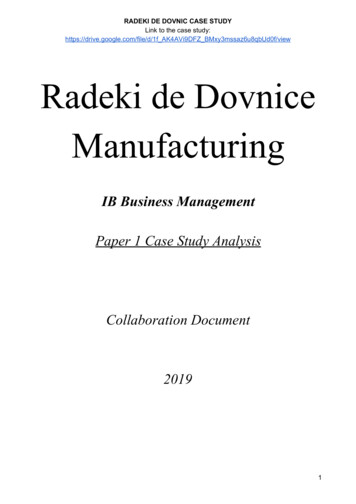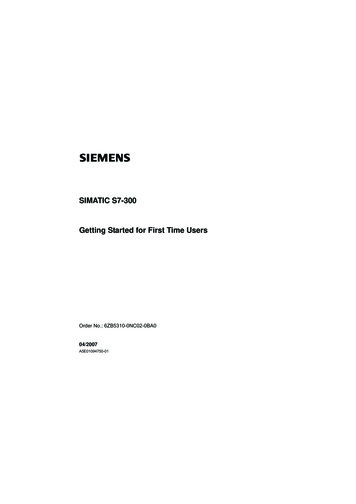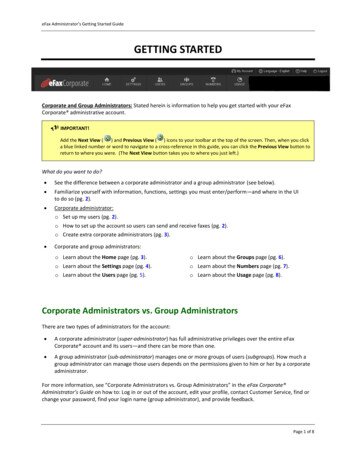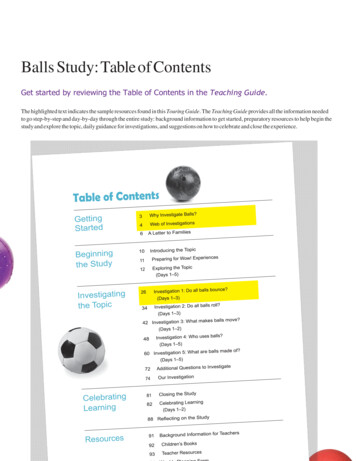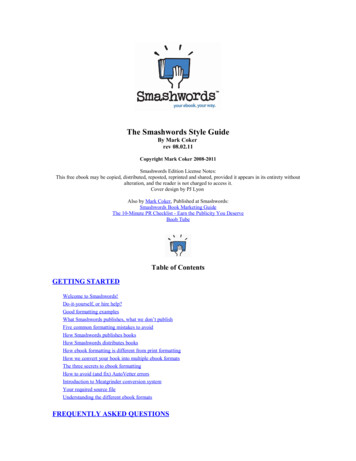
Transcription
The Smashwords Style GuideBy Mark Cokerrev 08.02.11Copyright Mark Coker 2008-2011Smashwords Edition License Notes:This free ebook may be copied, distributed, reposted, reprinted and shared, provided it appears in its entirety withoutalteration, and the reader is not charged to access it.Cover design by PJ LyonAlso by Mark Coker, Published at Smashwords:Smashwords Book Marketing GuideThe 10-Minute PR Checklist - Earn the Publicity You DeserveBoob TubeTable of ContentsGETTING STARTEDWelcome to Smashwords!Do-it-yourself, or hire help?Good formatting examplesWhat Smashwords publishes, what we don’t publishFive common formatting mistakes to avoidHow Smashwords publishes booksHow Smashwords distributes booksHow ebook formatting is different from print formattingHow we convert your book into multiple ebook formatsThe three secrets to ebook formattingHow to avoid (and fix) AutoVetter errorsIntroduction to Meatgrinder conversion systemYour required source fileUnderstanding the different ebook formatsFREQUENTLY ASKED QUESTIONS
FORMATTINGPre-PrepMaking Word BehaveStep 1: Make a back upStep 2: Activate Word’s Show/HideStep 3: Turn off Word’s “AutoCorrect” and “AutoFormat” featuresStep 4: Eliminate text boxesStep 5: The Nuclear MethodFormattingStep 6: Unify Manuscript around Normal paragraph styleStep 7: Managing and modifying paragraph styles, fontsStep 7a. How to choose the best paragraph separation method (first line indent or block?)Step 7b: How to implement your chosen paragraph separation methodStep 7b-a: How to define a proper first line indentStep 7b-b: How to define trailing “after” space for block paragraphsStep 7b-c: Special tips for poetry, cookbooks and learning materialsStep 7b-d: How to define proper line spacingStep 8: Check your normalized textStep 9: Why you should never use tabs or the space bar for indentsStep 10: Managing paragraph returnsStep 11: Managing hyperlinksStep 12: Designating chapter breaks, page breaks, section breaksStep 13: Working with imagesStep 14: Text justificationStep 14a: Centering textStep 15: Managing font sizesStep 16: Style formatting, symbols and glyphsStep 17: Headers and footersStep 18: Margins, page sizes and indentsStep 19: Add the Heading style to your Chapter headers (optional)Building NavigationStep 20: Building navigation into the manuscriptStep 20a: Creating the NCXStep 20b: Creating the linked Table of ContentsStep 20c: Advanced link building (Footnotes, Endnotes)Step 20d: Troubleshooting and testingFront MatterStep 21: Front matterStep 21a: Blurbs (optional)Step 21b: Title and copyright page (required!)Step 21c: Add a Smashwords license statement below copyright pageThe End of Your Book
Step 22: The end of your bookPOST-FORMATTINGStep 23: Preparing your cover imageStep 24: Review requirements for Premium Catalog distributionUploading Your Book to SmashwordsStep 25: How to upload your bookStep 26: How AutoVetter worksStep 27: After you publish – check your workStep 27a: Check for EPUBCHECK compliance (important!)How to Market Your BookStep 28: Read the Smashwords Book Marketing GuideHelpful ResourcesSend FeedbackAbout the AuthorAPPENDIXKeyboard shortcutsGETTING STARTEDWelcome to Smashwords!Welcome. Smashwords is the world’s leading ebook publishing and distribution platformfor indie ebook authors and publishers. The Smashwords Style Guide has helped over17,000 authors and publishers around the world collectively release over 44,000 ebooks.By following this Style Guide, you’ll learn how to quickly produce, publish anddistribute a high-quality ebook at no cost.The Style Guide is written for non-technical readers. No prior experience with MicrosoftWord is assumed or required. It presents simple, step-by-step instructions to help youformat your book to retailer requirements.Don’t be intimidated by the length of this guide. It has a lot of pictures.Books formatted to the Smashwords Style Guide earn inclusion in the SmashwordsPremium Catalog, which is what we distribute to major ebook retailers such as Apple,Barnes & Noble, Sony, Kobo, Diesel and others. Your book will also be available as amulti-format ebook at our own fast-growing retail operation, Smashwords.com, wherecustomers can discover and purchase the book for enjoyment on any e-reading device.
All you need to publish at Smashwords is a finished manuscript, a computer, an Internetconnection, Microsoft Word or similar word processor, and the time and patience tofollow this Guide. Patience is key. If you try to take short cuts and skip over the sectionsthat follow, you’ll only frustrate yourself and delay distribution.To learn some simple, time-saving keyboard tricks before you get started, see theAppendix at the end of this guide.Do-It-Yourself, or Hire Help? – If you don’t have the time, patience or skills toproperly format your masterpiece to Style Guide requirements, or you find yourselfcursing and swearing(never good!), consider hiring a fellow Smashwords author to helpyou. I maintain a list called “Mark’s List” with the names and contact information ofseveral Smashwords authors who have volunteered to provide low-cost SmashwordsStyle Guide formatting services for around 25/hr and up. The list also includes low-costcover designers. If you want a referral (we don’t earn a referral fee), send an email tolist@smashwords.com and you’ll receive it via instant autoresponder. Please note: if youutilize one of these formatting providers, you’re hiring them, not Smashwords. By hiringthem you will not receive any preferential customer support or fast-tracked approval.However, because they’re Smashwords formatting experts, they’ll give you a clean filethat will usually earn you Premium Catalog approval on the first attempt.Good Formatting Examples - Below are two examples of well-formatted Smashwordsbooks. You can download the free RTF which you can open and view in your wordprocessor.1. Jigglers by Gerald Weinberg 86145/jigglers-aremaca-century-later.rtf2. The Unsuspecting Mage: The Morcyth Saga Book One by Brian S. Pratt -one.rtfThis Smashwords Style Guide is a living document. As you learn formatting tips notpresented in this guide, please forward them to Mark Coker at first initial second initial atsmashwords dot com.What Smashwords Publishes, What We Don’t PublishBack to topSmashwords publishes only original and legal works, direct from the author or theexclusive digital publisher. We do not publish public domain books. We also don’tpublish incomplete or partial books, or books that appear elsewhere on the Internet under
other authors’ names, as is common with Private Label Rights scams. If you writeerotica, all your characters must be adults. And finally, we strongly discourage any bookthat advocates get-rich-quick “systems” for making money on the Internet. Smashwordsis a professional publishing and distribution service for serious writers only.Back to topFive Common Formatting Mistakes to Avoid:1. Improper Indents - Don’t use tabs or space bar spaces to create first line paragraphindents (instead, code your paragraph style to define a special first line paragraph indent:see step 7b-a below)2. Repeating Paragraph Returns - Never use more than four consecutive paragraphreturns (A.K.A. “hard returns,” created by hitting the ENTER key) to arrange text on thepage (this creates blank ebook pages on small-screened e-reading devices)3. Improper Paragraph Separation - Paragraphs require either first line paragraphindents or the block paragraph method. Otherwise your paragraphs run together and itbecomes unreadable because your reader’s eye can’t distinguish where one paragraphends and the next begins. Use one method or the other (indents are best for fiction andmuch non-fiction, blocks are usually only for non-fiction), but don’t use both. If you’reaiming for the block style, do not add paragraph returns between paragraphs onempty lines (to create the blank line). Instead, modify your paragraph style to add a 6 pttrailing “after” space following each the paragraph (see the Step 7 below, managing andmodifying paragraph styles).4. Font and Style Mistakes - Don’t use fancy non-standard fonts, colored fonts (colorsoften disappear on some e-reading devices), kerning, compressed or expanded fonts,large font sizes over 16pt, and don’t go overboard with multiple paragraph styles (makesyour ebook look ugly, and amplifies odds of unexpected problems). Modify yourparagraph styles so they don’t define fonts larger than 18pt.5. Copyright Page Mistakes - Don’t forget to include the required “front matter”(required for acceptance into the Premium Catalog), described in tip 21b below.How Smashwords Publishes Books:Back to top
After you carefully implement the formatting instructions in this Guide, your book isready to upload to Smashwords. Simply click “Publish” from any Smashwords web pageand follow the instructions to upload your book.Smashwords takes your original Microsoft Word .doc source file and converts it intomultiple ebook formats such as .EPUB, PDF. .RTF, .PDB, .MOBI, LRF and TXT, aswell as into online HTML and Javascript formats. By publishing in multiple formats,your book will be readable on any e-reading device, including the Amazon Kindle, AppleiPad, personal computers, the iPhone (via the popular Stanza e-reader app), Sony Reader,Kobo Reader, Android smart phones, etc.From the Publish screen, you can designate a percentage of your book that you want tomake available as a free sample. Most authors choose between 15-30%. If you don’tmake a free sample available, your book will not be distributed to some important outlets.Back to topHow Smashwords Distributes Books:Smashwords distributes your book via two primary mechanisms:1. Standard Catalog: This catalog contains all the books for sale at Smashwords.com.These books are also automatically listed in the native catalogs of Stanza on the iPhone,which is used by over 4 million people to discover and purchase ebooks; and Aldiko, ane-reading app for Google Android devices; and Word-Player, another e-reading app forAndroid devices. To qualify for distribution on Smashwords.com and in the Standardfeed, an author or publisher is simply required to abide by the Smashwords Terms ofService and follow the instructions in this Guide.2. Premium Catalog: This catalog is distributed to major online retailers and otherdistribution outlets. There’s no cost for inclusion, but your book must satisfy highermechanical standards required by the retailers such as having a quality book cover image,good formatting, a proper copyright page, and other requirements clearly outlined in thisStyle Guide and on our Distribution page at http://www.smashwords.com/distribution. Ifyou're a serious author or publisher, you want your books included in SmashwordsPremium Catalog because it offers your book unprecedented exposure at no cost.Back to topHow Ebook Formatting is Different from Print FormattingEbooks are different from print books, so do not attempt to make your ebook look like anexact facsimile of print book, otherwise you’ll only frustrate yourself by creating a poorlyformatted, unreadable ebook.
With print, you control the layout. The words appear on the printed page exactly whereyou want them to appear.With ebooks, there is no “page.” By giving up the control of the printed page, you andyour readers gain much more in return.Page numbers are irrelevant. Your book will look different on every e-reading device.Your text will shape shift and reflow. Most e-reading devices and e-reading applicationsallow your reader to customize the fonts, font sizes and line spacing. Your customerswill modify how your book looks on-screen to suit their personal reading preference andenvironment.By transforming your books into digital form, you open up exciting possibilities for howreaders can enjoy them.At Smashwords, our motto is “your book, your way,” and this means a reader should beable to consume your book however works best for them, even if that means they like toread 18 point Helvetica with blue fonts, lime background color, and triple spaced lines.Many e-reading devices and e-reading apps support some or all of these strange differenttastes.In order for us to prepare your words to be stirred up and reconstituted in this digitalsoup, it’s important your Smashwords source file is formatted to liberate the words indigital form.The book’s formatting will be and must be different from its paper-based formatting andlayout (for some works like poetry, the formatting is integral to the reading experience,and we can work with that too).Most readers want your words, not your fancy page layout or exotic type styles. This isespecially important for your ebook customers, because you want your work to displaywell on as many digital reading devices as possible so the reader can have their book theirway. Some of your buyers may want to read on the Amazon Kindle, others may prefer toread on the iPhone or Sony Reader, or even read on multiple devices. Others may wantto just read it on screen using one of the several e-reading applications, such as AdobeDigital Editions or FBReader.Back to topHow We Convert Your Book into Multiple Ebook FormatsThis Style Guide helps authors and publishers tweak their original source files to obtainthe best possible reading experience across multiple ebook formats and e-reading devices.Print publishing companies spend millions of dollars each year to convert their printbooks into digital formats. It’s a tough job, and often these conversions involve hiringhundreds of overseas cubicle laborers who painstakingly re-key and reformat texts intodifferent formats.
At Smashwords, we operate differently. Our Meatgrinder technology automates theprocess. Because our process is automated, the book you publish on Smashwords maynot be formatted as perfectly (or imperfectly - sometimes Meatgrinder actually improvesthe formatting) as you formatted it in your manuscript.There are pros and cons to such automated conversions.The advantage of this automation, especially if you carefully format your book to theStyle Guide, is that Meatgrinder will allow you to instantly publish a good-quality, multiformat ebook, ready to be enjoyed on any e-reading device. This automation also allowsus to offer this conversion and publishing service at no cost to you.Meatgrinder does well with straight-form narrative, so we excel at fiction, narrative nonfiction, poetry and other books that are mostly words. Luckily, straight narrativecomprises probably 75% of all books purchased by readers, and for most of the other25%, with some proper tweaks and yes, compromises, flexibility and patience, many ofthese books can work as well.Smashwords supports pictures and images, but here we lack the precision of print onpaper. With some Smashwords formats, page breaks will appear where you don’t expectthem. Images may not appear in the exact position you intended, or the print-qualityimage that looks great on glossy paper may not look so great on a black and white ereading device, or a small cell phone. In other words, unpredictable things will happen.With patience, experimentation and an open mind, you can make it work. Remember,good quality is the goal, not perfection.Some format outputs have limitations. For example, a picture book or manga that’s allimages is impossible to convert into plain text (it wouldn’t be a picture book anymore!).Other books may look great in .RTF or PDF, but not so great on one of our onlinereaders.Meatgrinder has other limitations. It doesn’t support tables or columns. It doesn’t takefull advantage of some of the capabilities of formats such as EPUB and .MOBI. We’reaware of the limitations, and you should be too.In the meantime, the benefits of such minor compromises outweigh the downside. Bygiving up a little, you gain a lot by making your book accessible to millions of potentialreaders across our ever-growing distribution network.Some folks who read the paragraphs above come to the conclusion that Smashwordswants a plain text book without formatting. Not true! As you read on, you’ll discoverthat Smashwords still gives you great control over formatting and styles.We care about quality, and you should too. If you ever hear an author or reader complainthat their Smashwords book looked like [insert your favorite expletive], it means theauthor didn’t follow the Style Guide. Take the time to follow the guide. You’ve investedyears – possibly even a lifetime – to write your masterpiece, so take 30 minutes or anhour to study the Guide and learn how easy it is to create a good-looking multi-formatebook you and your readers will be proud of.
Back to topThe Three Secrets to Ebook Formatting:Keep it Simple, Keep it Simple, Keep it Simple!The secret to ebook formatting success is “Keep it Simple!” Unnecessarily complexformatting or layout will hinder the readability of your ebook. If you attempt to makeyour ebook an exact facsimile of your print book, you will cause yourself – and yourreaders – unnecessary frustration. It may also cause your ebook conversions to fail.Re-envision your book as free flowing text with only the essential formatting. Restrictyour formatting to Normal paragraph style for the bulk of your book, one paragraphreturn at the end of each paragraph, proper first line paragraph indents (see tips below onhow to create), italics, bolds, a Heading style only for your chapter headings, and veryfew if any additional paragraph styles beyond that.Simple doesn’t mean you can’t use formatting, or you can’t use styles. It just means thatif your current formatting includes 15 or 30 different custom paragraph styles, you’reasking for trouble.Back to topHow to Avoid AutoVetter Errors:AutoVetter is Smashwords’ automated technology that inspects your book the momentyou publish it and provides you instant feedback on potential formatting problems.You’ll find your errors documented in the Dashboard after you publish, underneath the“Premium Status” column. If the link reads, “requires modification,” click the link.AutoVetter is your friend.If you receive AutoVetter errors, fix them immediately. Otherwise, the errors will delayor prevent your book’s acceptance into the Smashwords Premium Catalog. The momentAutoVetter tells you about the errors, you can fix them and then upload a new version viayour Dashboard’s “upload new version” link.The following errors may prevent your book from gaining inclusion in the PremiumCatalog:- more than 4 consecutive paragraph returns in a row (creates blank ebook pages)- tabs (eliminate all tabs, which you created by hitting the “Tab” key)- extra paragraph returns between paragraphs in an attempt to create a blank line- exotic fonts (instead, stick with Times New Roman, Garamond and Arial)
- large font sizes (11 or 12pt is best, 14pt is a recommended maximum)- indents made with space bar spaces or tabs (the most common bad habit of all authors)- text in columns (we don’t support columns)- text in tables (ebooks don’t handle tables. Import tables as images)- text in text boxes (Ugh, the horror!)- multiple text or paragraph styles for your body (for example, don’t mix Normal stylewith Body Text style)- automatic footnotes (not supported, may cause the conversion to fail)- text wrapped around floating images (instead, right mouse click on image, click FormatPicture: Advanced: In Line with Text, then use Word’s center button to center)- and finally, to avoid the copyright error, carefully follow tip 21b belowBack to topIntroduction to MeatgrinderWe affectionately call our file conversion system Meatgrinder. In the last two years, wehave continually enhanced it to produce high quality ebooks. The most recent upgradewas August 2010, where we made a series of great improvements to our EPUB andMOBI files.Your source file, a Microsoft Word .doc document, goes in one end of the Meatgrinderand comes out the other end as multiple DRM-free digital book files for use on amultitude of e-reading devices such as the Amazon Kindle, Barnes & Noble nook, SonyReader, iPhone, iPod Touch, Apple iPad, a computer screen or virtually any other ereading device.If you ignore the formatting requirements of the Smashwords Style Guide, Meatgrinderwill turn your book into hamburger. Please follow the instructions!
Back to topYour Required Source FileThe file you upload into the Meatgrinder should be a Microsoft .doc file (the default). Ifyou’re a screenwriter, scriptwriter and playwright and you work in a program called FinalDraft, save your document as an RTF file (however, you will need to manually correctthe margins), and then open it in Word, save it as a Word .doc, and clean up from there.PDF Source Files (Not allowed): You cannot upload a source file as a PDF. If youonly have your book in PDF form, here’s a free online service that will convert your PDFinto a Word doc: http://www.pdftoword.com/ You upload your PDF to them and thenthey email it to you as a Word file. But be warned, the output it gives you will *not* beready to publish on Smashwords. You will still need to perform clean-up. To save time,you’re better off contacting whoever converted your original manuscript into PDF andask them to forward you the original source file, saved as either a Word .doc or .RTF file.If You Only Have a Print Book: Many authors only have print copies of their books.How do you bring your book to life as an ebook? It’s easier than you might think.Consider this cool service called Blue Leaf Book Scanning, which uses optical characterrecognition technology to convert your book back into digital form. For around 25.00,they will scan your print book and send it to you as a Microsoft Word file. I’ve seen theraw files they produce, and they’re remarkably accurate. However, the service is notinfallible. The Word file they send you will still require careful proofing, editing andreformatting. http://www.blueleaf-bookscanning.com/book scanning service order.html
InDesign Source Files: InDesign is a common layout application used by professionalpublishers. Smashwords does not accept InDesign files. However, from InDesign, youcan export your book to .RTF format. Once it’s in RTF format, you can reopen the file inMicrosoft Word, save it as a Word .doc, and then remove all the garbage introduced byInDesign (you’ll have tabs in random places, and other ugly formatting). The fastest wayto clean up an RTF from InDesign (or any file, for that matter) is to use what I call theNuclear Method. With the Nuclear Method, you open your file in Word, copy andpaste it into Windows Notepad (or some other simple text editor that strips out allformatting), close Microsoft Word, then reopen Word to a fresh new Word document,then copy and paste the book from Notepad back into Word, and then carefully re-applythe minimal necessary formatting by following the Style Guide.HTML Source Files: We previously allowed HTML file uploads, but now we no longerallow them because most HTML files provided to us contained serious corruption asdefined by the WC3 HTML Validator at http://validator.w3.org/check and as a resultdidn’t upload properly. If you only have your source file as an HTML file, follow theseinstructions: 1. Open the HTML document in a browser. 2. Copy and paste the entiredocument into a new Word doc by clicking "Edit: paste special" within the Word menu,then selecting "unformatted text" as the output. 3. From here, you'll find that you've gota consistent number of spaces, such as four spaces, making up your indents. This won'twork, so do a CTRL H (press the CTRL key and the H key at the same time) search andreplace and search for p space space space space (a paragraph return followed by fourtaps on the space bar) and replace with only p. This will eliminate the leading spaces atthe beginning of each paragraph. 4. Next, CTRL A the document, right mouse click,click paragraph, and then under “special” do a first line paragraph indent of .25”. 5.Next, clean up the remaining minor issues, like manually removing the indents from yourtitle and copyright pages, and, using Word’s center button, center those sections.Back to topUnderstanding the Different Ebook FormatsOne of the important benefits of Smashwords is that we take your single file and convertit into multiple ebook formats. Why is this so important to the success of your book?Because customers read on many different devices, and the more formats you offer, themore books you’ll sell. In early January 2010, we did a survey of the most popular ebookformats for Smashwords customers. The results were interesting. Although PDF is themost popular ebook format, two thirds of customers preferred formats other than PDF.You can read the survey yourself at ok-formats-revealed.html.You should publish your book into as many digital formats as possible (even if certainformats translate less well than others) because this expands your potential audience ofreaders. Review the outputs of each format for acceptability after you publish.Here’s a summary of the formats offered:
EPUB - This is your most important format! EPUB is an open industry ebookformat. This is the format we distribute to Apple, Barnes & Noble, Sony, Kobo, DieseleBooks, and others. If your book is available in epub, it can be read on the most popularebook readers and ebook reading software applications (Like Stanza on the iPhone orAldiko on Android devices), and will gain the widest distribution via Smashwords’distribution outlets (EPUB is a requirement for inclusion in Smashwords’ PremiumCatalog, and it’s what we distribute to every retailer except Amazon).Mobipocket (Kindle) – Mobipocket, A.K.A. MOBI, allows your books to be read on theAmazon Kindle, so this is an important format for you. Mobipocket is supported onmany handheld devices and e-reading applications. Mobipocket is a requirement fordistribution to Amazon.Palm Doc (PDB) - PalmDoc is a format primarily used on Palm Pilot devices, butsoftware readers are available for PalmOS, Symbian OS, Windows Mobile PocketPC/Smartphone, desktop Windows, and Macintosh. Be sure to turn off “smart quotes” inyour source file, otherwise they may appear garbled in your PDB file. Our PDB is littlemore than ugly plain text.PDF - Portable Document Format, or PDF, is a file format readable by most devices,including handheld e-readers, PDAs, and personal computers. It’s a good format if yourwork contains complex layout, charts or images. Odds are, if your work looks good inMicrosoft Word it will look good in PDF. PDF is also a good option for readers whomay want to print out your book on their home computers. On the negative side, PDF isa rigid, inflexible format because it’s not reflowable, so it’s horrible for reading novels.Your customers can’t easily change the font size or style to match their preferences, thetext isn’t reflowable, and the reader is forced to read page by page.LRF - This is the old format for the Sony Reader. Sony has shifted to the EPUB format,so LRF is less important than it once was, though it’s still useful to users of the oldergeneration Sony Readers.RTF - Rich Text Format, or RTF, is a cross-platform document format supported bymany word processors and devices. It’s usually pretty good at preserving the originalformatting from Word documents. It is not efficient with lots of images.Plain Text - Plain text is the most widely supported file format. It works on nearly allreaders and devices. It lacks formatting, but will work anywhere. For best results withplain text, your source document should not contain images or fancy formatting.HTML SmashReader – This is our online reader that allows customers to sample orread your book from their web browser. Your sample pages will be indexed by Google,which will increase the ability for potential customers to find your book, even if theydidn’t know your book is what they were looking for. Think of it as serendipity onsteroids. If your book looks good in our HTML reader, it will probably also look good inEPUB and MOBI. Linked tables of contents (ToCs) don’t work in the HTML reader.
Javascript SmashReader - This online reader isn’t indexable by search engines like theHTML reader, but it does allow your readers to customize their reading experience. Theycan increase or decrease the fonts, change the line spacing, change the font, change thefont color or the background color. Our Javascript Reader has always been a bit buggy,so if you see strange characters along the top of the page, ignore them. Linked ToCsdon’t work here.More options coming - In the future, we’ll add support for other formats based on authorrequests. If there’s a particular format you want, drop us a note.*** ***Back to topFrequently Asked QuestionsQ. Can you show me an example of a well-formatted book?Yes! Check out Gerald Weinberg’s Jigglers, which is a good formatting example.Q: How long will it take for me to format my book for Smashwords?This depends on your knowledge of Microsoft Word. The average author, if they takethe time to carefully study and implement the Style Guide, can successfully completetheir formatting in under two hours. Most Smashwords experts can complete a book inunder one hour. Novels are easiest. If you decide to skip the Style Guide because youalready have decades of experience in publishing, then you’ll frustrate yourself and wastetime. Don’t be discouraged by the length of this Guide. It has a lot of pictures to helpguide even computer novices down the path to formatting success, and it’ll save youmoney in the process. We created Smashwords so you shouldn’t have to pay anyone apenny to publish with us. If you don’t have the time, skills, or patience to follow theinstructions, and you’d rather hire someone to
What Smashwords Publishes, What We Don't Publish Back to top Smashwords publishes only original and legal works, direct from the author or the exclusive digital publisher. We do not publish public domain books. We also don't publish incomplete or partial books, or books that appear elsewhere on the Internet under


